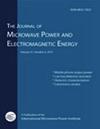石墨和TiO2作为微波脱蜡感受器在艺术品陶瓷壳体铸造工艺中的评价
IF 1.5
4区 工程技术
Q4 ENGINEERING, CHEMICAL
Journal of Microwave Power and Electromagnetic Energy
Pub Date : 2022-08-10
DOI:10.1080/08327823.2022.2106730
引用次数: 0
摘要
美术车间传统的铸造脱蜡工艺存在的主要问题是气体排放大、蜡损失达80%、电耗高、操作人员风险大。尽管需要使用电磁感受器捕获辐射能量并将其转化为热量,但引入微波技术对陶瓷壳模具进行脱蜡可以最大限度地减少这些问题。本文介绍了以TiO2和石墨为感受器的不同微波脱蜡试验。结果表明,该技术是可行的,使铸造过程的模具破损率低,并显着减少了排放的气体和电力消耗。该技术允许在相同的操作中回收约90%用于中小型尺寸物体的蜡。测试表明,与传统的闪速脱蜡技术相比,用作感受器的材料的选择、应用区域和功率制度是实现可控、柔软和非侵蚀性脱蜡的基础,既适用于艺术模具,也适用于环境。通过这种方式,可以改变艺术品陶瓷外壳的铸造,以实现高水平的性能和安全,并节省能源,时间和材料。本文章由计算机程序翻译,如有差异,请以英文原文为准。
Evaluation of graphite and TiO2 as susceptors for microwave dewaxing in ceramic shell casting processes of artworks
Abstract The main problems of the traditional foundry dewaxing processes in fine arts workshops are the emission of gases, the loss of 80% of the wax, the high electrical consumption, and the high risks for the operators. The introduction of the microwave technology for dewaxing of ceramic shell molds allows to minimize some of these problems, although the use of electromagnetic susceptors that capture the radiated energy and transform it into heat is required. This article describes different microwave dewaxing tests using TiO2 and graphite as susceptors. The results obtained show that this technique is viable, allowing the casting process to be carried out with a low percentage of breakage problems in the mold and significantly reducing the emitted gases and electricity consumption. The technique allows to recover in the same operation around 90% of the wax used in small and medium format objects. The tests show that the selection of the material used as a susceptor, the area of application and the power regimes, are fundamental to enable a controlled, soft and non-aggressive dewaxing, both for the art molds and for the environment, as opposed to the traditional Flash Dewaxing technique. In this way, it is possible to change the foundry of ceramic shells for artworks to achieve high levels of performance and safety, and to save energy, time and materials.
求助全文
通过发布文献求助,成功后即可免费获取论文全文。
去求助
来源期刊

Journal of Microwave Power and Electromagnetic Energy
ENGINEERING, CHEMICAL-ENGINEERING, ELECTRICAL & ELECTRONIC
CiteScore
2.50
自引率
6.70%
发文量
21
期刊介绍:
The Journal of the Microwave Power Energy (JMPEE) is a quarterly publication of the International Microwave Power Institute (IMPI), aimed to be one of the primary sources of the most reliable information in the arts and sciences of microwave and RF technology. JMPEE provides space to engineers and researchers for presenting papers about non-communication applications of microwave and RF, mostly industrial, scientific, medical and instrumentation. Topics include, but are not limited to: applications in materials science and nanotechnology, characterization of biological tissues, food industry applications, green chemistry, health and therapeutic applications, microwave chemistry, microwave processing of materials, soil remediation, and waste processing.
 求助内容:
求助内容: 应助结果提醒方式:
应助结果提醒方式:


